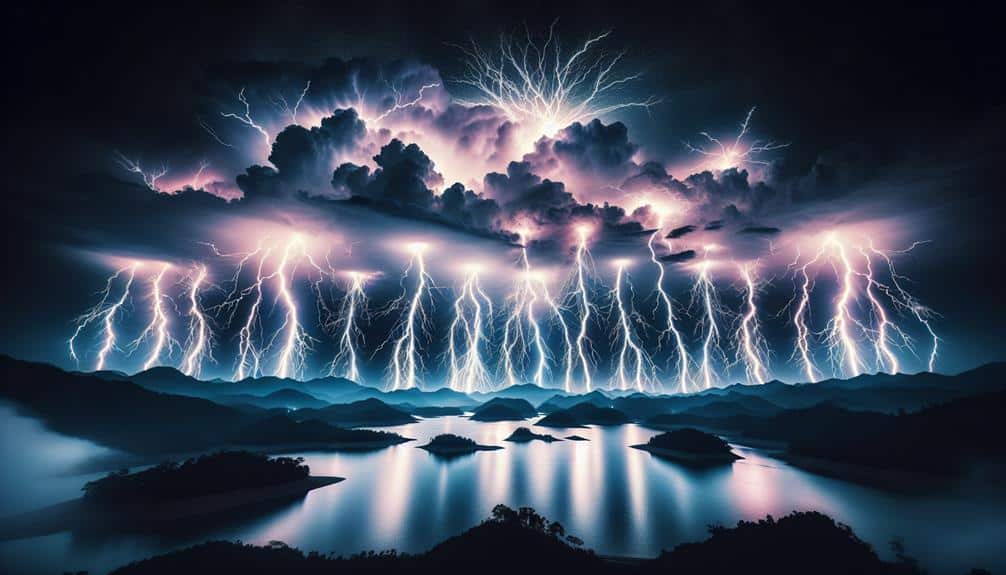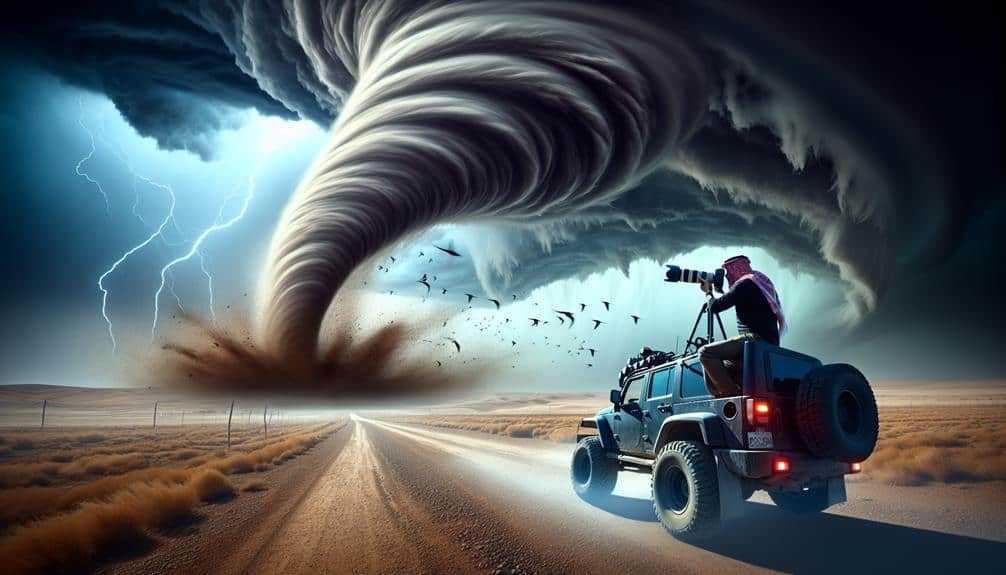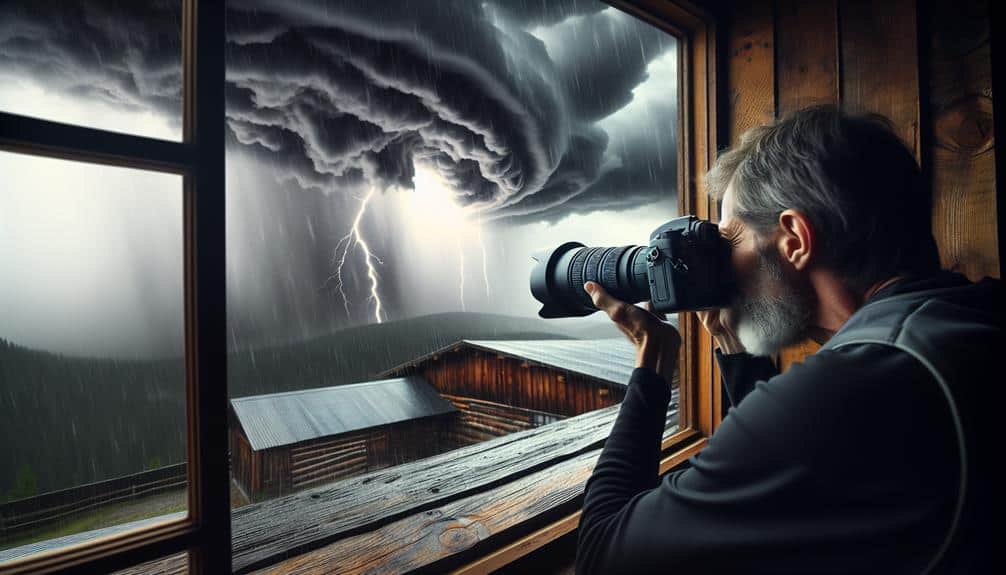To photograph dramatic stormy coastal scenes, we need to use a wide-angle lens for vast landscapes and a telephoto for isolating powerful elements. A sturdy tripod and remote shutter release are essential for long exposures, capturing dynamic motion. Mastering weather forecasts helps us anticipate perfect moments while ensuring safety. Artistic techniques like the Rule of Thirds and leading lines enhance composition. We often use ND filters for long exposures and post-process with HDR techniques to add depth and drama. By balancing these technical and artistic elements, we create striking images that convey the storm's intensity and coastal majesty.
Key Points
- Use a wide-angle lens to capture the vastness and drama of coastal storms.
- Employ a sturdy tripod and remote shutter release to stabilize your camera in high winds.
- Monitor weather forecasts and synoptic charts to anticipate dramatic storm conditions safely.
- Adjust shutter speed and use Neutral Density Filters for dynamic long exposures of waves and clouds.
Choosing the Right Gear
Selecting the appropriate gear for photographing stormy coastal scenes is necessary to capturing the dramatic interplay of light and weather conditions. First and foremost, our lens choice is pivotal. A wide-angle lens allows us to encompass the vastness of the scene, from the turbulent ocean waves to the ominous clouds. On the other hand, a telephoto lens can isolate and magnify specific elements, such as lightning strikes or crashing waves, providing a different perspective.
To ensure tripod stability, especially in windy conditions, a sturdy tripod is required. It prevents camera shake, which is particularly important for long exposure shots that capture the motion of waves and clouds. Adding weight to the tripod, such as hanging a bag from its center, can further enhance stability.
Utilizing a remote shutter release is essential for minimizing camera movement. It allows us to take photos without physically touching the camera, which is pivotal when shooting in challenging lighting conditions. This technique is especially beneficial during the golden hours of sunrise or sunset, where light variations can dramatically affect the exposure.
Understanding Weather Patterns
To capture the dramatic essence of stormy coastal scenes, we need to master the art of reading weather forecasts and identifying storm signals. By interpreting synoptic charts and understanding meteorological indicators, we can anticipate the perfect moments for our shots.
Detailed knowledge of weather patterns not only guarantees our safety but also enhances the artistic quality of our photographs.
Reading Weather Forecasts
Understanding weather patterns is vital for capturing dramatic stormy coastal scenes, as it allows us to anticipate and prepare for the dynamic conditions that make for compelling photographs.
By reading weather forecasts, we can interpret the key elements that signal an impending storm. Let's explore how we can interpret these forecasts effectively.
First, we need to analyze cloud formations and wind direction. High, wispy cirrus clouds often precede a storm front, while cumulonimbus clouds are indicative of intense storm activity. Wind direction can also reveal much about an approaching storm; coastal winds shifting to come from the ocean often indicate a brewing tempest.
Next, examining atmospheric pressure and humidity levels is essential. A sudden drop in atmospheric pressure generally indicates stormy weather is imminent. We should be equipped with a barometer or use reliable weather apps to monitor these changes.
Elevated humidity levels, especially when coupled with falling pressure, suggest that moisture-laden air is primed for dramatic weather events.
Identifying Storm Signals
Recognizing storm signals is a vital skill for photographers aiming to capture the raw beauty of tumultuous coastal scenes. We need to develop a sharp eye for cloud formations, as they often herald incoming weather changes. Cumulonimbus clouds, for example, indicate powerful thunderstorms, while towering, dark clouds signal imminent heavy rain and lightning strikes. Understanding these visual cues allows us to position ourselves for the most dramatic shots.
Wind patterns play a pivotal role in storm prediction. By observing sudden shifts in wind direction and speed, we can anticipate the storm's path and intensity. Strong, gusty winds often precede a storm, stirring the ocean swells and creating dynamic, photogenic waves. Monitoring this interplay between wind and water helps us capture the raw power of nature.
Ocean swells are another key indicator. Large, rapidly forming swells suggest an approaching storm, offering a chance to photograph the ocean in its most turbulent state.
Safety Precautions
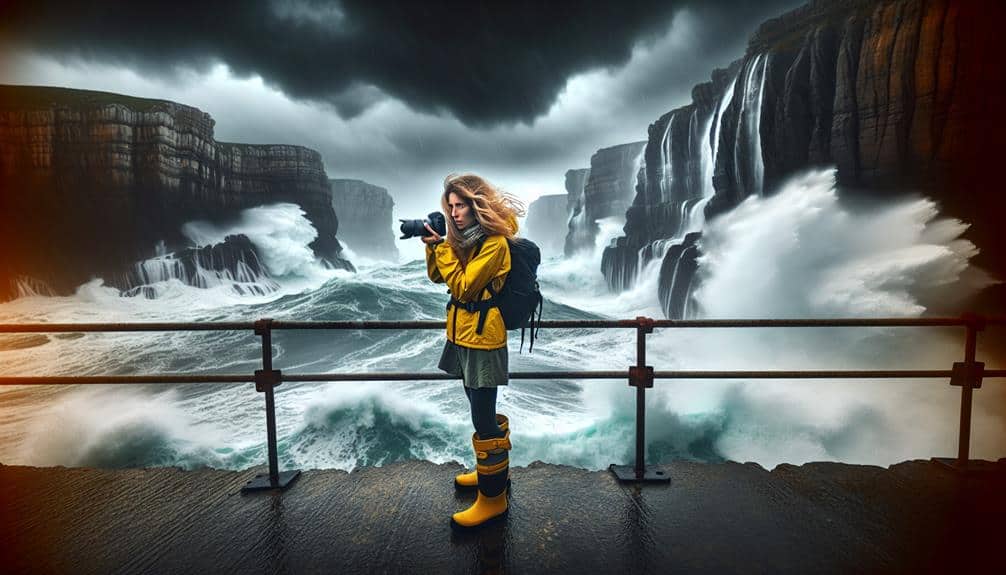
When photographing stormy coastal scenes, we must prioritize our safety by staying aware of rapidly changing weather conditions and potential hazards. Preparing an emergency plan and conducting a risk assessment are essential before we even step foot on the shoreline. This involves identifying safe escape routes and knowing the nearest shelters.
Furthermore, our gear needs to be up to the task. Using weatherproof equipment is non-negotiable; salty sea spray and torrential rain can easily damage unprotected cameras and lenses. Equally important is donning waterproof clothing to make sure we stay dry and focused. Wet, cold conditions can quickly escalate into a dangerous situation if we're not adequately prepared.
Here are three essential safety precautions to keep in mind:
- Check Weather Forecasts: Before heading out, consult detailed weather forecasts and tide tables. Apps and websites provide real-time updates that can help us avoid unexpected storms or high tides.
- Stay Aware of Surroundings: Keep an eye on the waves and weather. Rogue waves can appear without warning, and lightning is a serious threat in stormy conditions.
- Have a Communication Plan: Ensure our phone is fully charged and in a waterproof case. Inform someone of our plans and estimated return time.
Composition Techniques
Let's explore how employing the Rule of Thirds and Leading Lines can elevate our stormy coastal photography.
By positioning key elements along the grid intersections, we create balanced and dynamic compositions.
Additionally, using natural leading lines like shorelines and waves guides the viewer's eye through the frame, enhancing the visual impact.
Rule of Thirds
Mastering the Rule of Thirds in stormy coastal photography allows us to create balanced and compelling compositions by strategically positioning key elements along the intersecting lines. By dividing our frame into nine equal parts, we can place points of interest—like a towering lighthouse or a crashing wave—at the intersections, ensuring that the viewer's eye is naturally drawn to these focal points.
This technique also enhances color contrast, making the dramatic interplay between dark storm clouds and the ocean's blue hues even more striking.
To achieve visual balance and depth perception in our shots, we should consider the following:
- Focal Point Placement: Position the primary subject, such as a rocky outcrop or a sea stack, on one of the intersection points. This draws immediate attention while allowing the surrounding stormy elements to frame the scene.
- Foreground Interest: Incorporate elements like driftwood or coastal flora in the lower third to add depth and guide the viewer's eye through the image.
- Horizon Alignment: Align the horizon along the upper or lower third, avoiding dead-center placement, which enhances visual balance and emphasizes either the stormy sky or the turbulent sea.
Leading Lines
Incorporating leading lines in our stormy coastal photography can transform a static scene into a dynamic visual journey, guiding the viewer's eye from the foreground to the dramatic elements in the background. Leading lines, whether natural or man-made, serve as powerful compositional tools that enhance our images' visual impact.
Shorelines, jagged rocks, and even drifting seaweed can create pathways that draw the eye toward the stormy horizon, where atmospheric drama unfolds. By carefully positioning these elements within our frame, we achieve composition balance, ensuring the scene feels cohesive and engaging.
We should always be mindful of how lighting effects interact with our leading lines. For example, the interplay of light and shadow on a wet, reflective surface can amplify the sense of depth and texture, adding layers of complexity to the image.
Mastering leading lines involves both technical proficiency and artistic insight. We need to be patient, waiting for the right moment when the interplay of elements aligns perfectly. With practice, we can use leading lines to create compelling narratives in our photographs, capturing the raw, untamed beauty of stormy coastal scenes with unparalleled visual impact.
Capturing Motion
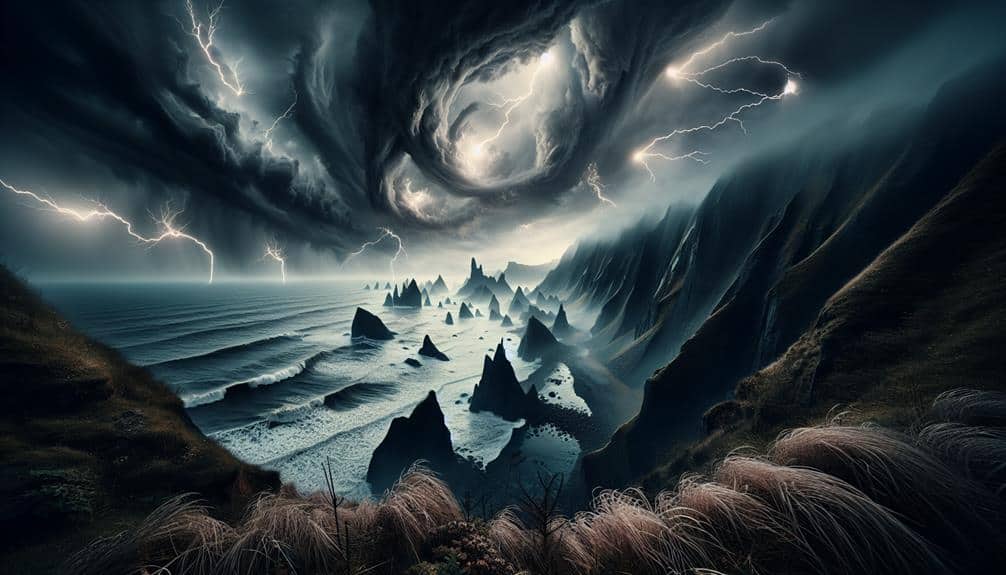
One key technique for capturing motion in stormy coastal scenes is using long exposure to blur the water and convey the dynamic energy of the waves. This method allows us to create a sense of movement and drama, transforming turbulent waters into ethereal, flowing forms.
Conversely, freezing action with a fast shutter speed can capture the raw power and intensity of crashing waves, making each droplet appear suspended in time.
To master these techniques, we should consider the following:
- Shutter Speed: For long exposure, set the shutter speed between 1 to 30 seconds. This depends on the light conditions and the desired level of motion blur. For freezing action, a shutter speed of 1/1000 second or faster is ideal.
- Tripod Stability: A sturdy tripod is essential for long exposure shots to avoid camera shake and guarantee crisp, clear images. It's our anchor in the tempestuous environment of a stormy coast.
- Neutral Density Filters: These filters are indispensable for long exposure photography, especially in bright conditions. They allow us to slow down the shutter speed without overexposing the image, capturing the fluidity of the scene.
Post-Processing Tips
When refining our stormy coastal photographs, leveraging advanced post-processing techniques can dramatically enhance the mood and impact of the images. We begin by focusing on color grading to create a cohesive and compelling palette. Adjusting the white balance can remove any unwanted color casts, while selectively enhancing blues and grays can evoke the chilling essence of a stormy seascape.
Next, enhancing contrast is essential for adding drama. By boosting the contrast, we can emphasize the turbulent interplay between light and shadow, making the clouds appear more menacing and the waves more powerful. Utilizing high dynamic range (HDR) techniques can help in preserving details in both the highlights and shadows, ensuring the photograph remains balanced and visually arresting.
Creating mood involves more than just technical adjustments. We can use local adjustments to darken the sky, creating an ominous atmosphere that draws viewers into the scene. Adding a subtle vignette can focus attention on the central elements, heightening the sense of drama.
Frequently Asked Questions
What Are the Best Times of Day to Photograph Stormy Coastal Scenes?
We believe the best times are sunrise and sunset during the golden hour for warm, dramatic light, and the blue hour for moody, ethereal tones. These periods provide dynamic lighting and atmospheric conditions perfect for stormy coastal scenes.
How Can I Protect My Camera From Saltwater Spray?
Amidst the roaring waves, we shield our gear with waterproof covers and silica gel. Lens filters guard the glass, while an air blower keeps it clear. Our cameras stay safe, capturing the tempest's wild beauty without constraint.
Are There Specific Coastal Locations Known for Dramatic Storm Photography?
Yes, there are iconic landmarks like Oregon's Cannon Beach and Cornwall's rugged cliffs. We recommend attending photography workshops there to master capturing the drama and artistry of stormy coastal scenes with expert guidance.
How Do I Prevent Lens Fogging in Humid, Stormy Conditions?
Did you know 70% of photographers face lens fogging in humid conditions? To prevent it, we use weather-sealed gear, anti-fog lens filters, and regular lens cleaning. These methods guarantee clear, stunning captures even in stormy weather.
What Are Some Creative Ways to Incorporate Reflections in Stormy Coastal Photos?
Let's use long exposure to capture dynamic water reflections and employ composition techniques like leading lines and the rule of thirds. This approach helps us create visually compelling, dramatic images that evoke a sense of freedom and awe.
